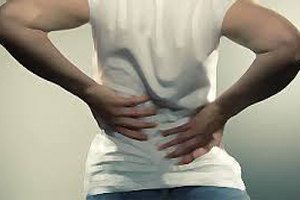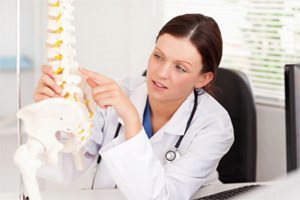Among them – lumbago, radiculitis, osteochondrosis and other pathological changes in the lumbosacral spine. One should not treat it carelessly, because the lower back pain not only can achieve incredible strength, making the person's life unbearable, but also be a symptom of dangerous diseases.
Lower back pain can be varied: sharp or dull, aching or burning, local (to show in one place) or covering the entire back. Manifest discomfort in different ways: sometimes sharply, suddenly, and sometimes gradually, increasing with each passing day.

Response to pain and ability to tolerate it depends on many factors: age, mental characteristics, accompanying symptoms, and more. But in any case can not throw the disease to chance. Timely treatment will help to avoid dangerous consequences.
To diagnose the cause of back pain, the necessary examination of the spine and certain additional procedures: x-ray examination, computed or magnetic resonance tomography.
Attacks of pain in the lumbosacral appear in the course of life, about 80% of modern inhabitants of European countries. Acute or chronic back pain – a consequence of a variety of neurological, degenerative diseases in women and men. In some cases, back pain is a consequence diseases of internal organs, obesity, stress and mental disorders.
Causes of lower back pain
The problem of chronic lower back pain takes rampant. The average age of onset is decreasing rapidly, currently he is 35-45 years. Even the cases of children and adolescents.
The prerequisite for the development of pain syndrome in the lower back – sedentary lifestyle of modern man, which leads to a decrease in stability of the lower back, the most vulnerable division of the skeleton. Pain can accompany many diseases, they have become a frequent reason for seeking a neurologist, urologist, surgeon, gastroenterologist and a gynecologist. Projected further deterioration of the problem. The next generation is not a healthy way of life.
Lower back pain in women
Arise in the period of gynecological diseases or are a consequence of the peculiarities of female physiology:
- Gynaecological diseases. Inflammation of the adnexitis, accompanied by pain in the abdomen, and sometimes pain radiating to the lower back (pain on one or both sides), manifested by symptoms from the intimate sphere (the inability to become pregnant, long spotting before and after menstruation pain increases during sexual intercourse);
- Pregnancy;
- Menopause;
- Pain is a consequence of enhanced suspiciousness, often found in women. In-depth, comprehensive study did not reveal any pathology. This problem can occur intermittently or constantly. Treated psychological correction. Such pain can occur outside the influence of menopause.
Lower back pain in men
Recurrent pain arise in connection with peculiarities of professional activity of men, including, if the pain:
- not correspond to the physiological status of the organism of the man;
- linked to professional risks (working in the cold, drafty).
Lower back pain in both men and women
Arise in connection with acute diseases of the gastrointestinal tract, surgical complications, kidney disease, metabolic disorders, diseases of the infectious nature of neoplasms (benign, malignant).
- Appendicitis. Characterized by pain localized in the right iliac region, sometimes may radiate to the lower back, usually right side of the body. Found an indefinite pain in the lumbar region.
- Pathology of the small intestine. Accompanied by symptoms characteristic of disorders of the gastrointestinal tract. The pain radiates to the lower back due to irritation of the fibres of the lumbar nerves.
- The cholecystitis. Pain reminiscent of symptoms of appendicitis. Usually localized on the right side in the iliac region or in the navel. Sometimes felt in the lower back when involved in the pathogenesis of fibers of spinal nerves.
- Pancreatitis. Typical girdle pain, around the body in the waist area, which is displayed to the lumbar. Combined with typical pancreatitis symptoms – vomiting, defecation violation, a touch on the tongue. If the cause of the pain – pancreatitis, the area of the spine at the feeling, not reacting in response to application of force.
- Adhesions after surgery. Occur after laparotomy or abdominal surgery on the abdominal organs, sometimes diagnosed congenital adhesions. The pain is localized in different parts of the abdominal wall, radiating to the lower back.
- Of kidney disease. Lower back pain combined with headache, increase in diastolic (lower) threshold blood pressure, and edema. Characteristic changes in laboratory studies, urine tests, instrumental studies, renal ultrasound, MRI;
- Obesity fourth degree. This extreme increase fat mass in humans. The body mass index of the fourth degree (under 25 years) = 40, the second group (after 25) = 41. It is defined as the ratio of the mass (kg) to double height (m). Causes pressure on lower back clear without explanation.
- Of infection involved in the pathogenesis of bone tissue, such as extrapulmonary (bone) tuberculosis. Is manifested by pain in the bones. Localization of pain in the lower back is related to the fact that it is the massive division of the spinal column, and he is prone to maximum loads. Symptoms associated with clinical picture of chronic infection. Reveal a slight hyperthermia, fatigue, headache, symptoms of lesions of the nervous system, laboratory reveal tubercle Bacillus.
- Myositis – inflammation of muscles. The muscles of the lumbar area carry a heavy load so the inflammation of the lumbar area are common. The disease develops as a result of hypothermia, penetration of pathogens of viral (herpes Zoster), bacterial infections (Staphylococcus, Streptococcus and other bacteria) in the tissue of this zone. Manifested by fever, severe pain, developing suddenly after the local or General hypothermia. Chronic stage of the disease manifested by aching pain, sometimes with involvement of the tissues of the skin and subcutaneous tissue (dermatomyositis). Diagnosis is based on clinical examination of the patient, inspection, palpation and laboratory methods.
- The growth of benign and malignant tumors along the nerve fibers, innervating the lower back. The symptoms are varied, and correspond to the stage of disease and localization of pathology.
Persistent and recurring lower back pain

There are various classifications of pain, including, depending on the duration.
- Recurrent pain, usually associated with exercise, the physiological characteristics of the human body or acute diseases of the internal organs.
- Constant, acute, chronic pain, caused by irreversible pathological processes in the organism in diseases of the musculoskeletal system of the human skeleton and deep lesions of the vessels of the legs.
Periodic lower back pain - as they are called because they disappear after recovery and elimination of the source of pain.
The origin of pain may differ in women or men, or equally applies to men and women.
Persistent back pain usually caused by inflammation and irreversible dystrophic and degenerative processes in bone and cartilage, severe disorders of the blood vessels of the legs. Persistent pain, to a lesser extent, associated with lesions of the muscles and internal organs.
The constant pain is called when the remove the source of the pulse is difficult because of development of irreversible processes in bone and cartilage. Degenerative and dystrophic processes are usually not subject to a complete cure. They can pause or stop for a while. In some cases the pain persists after replacing the damaged tissue with the implant.
Recurrent and persistent pain, often have a close relationship with each other, so the temporary pain becomes constant.
For example, bone tuberculosis causes malnutrition of the cartilage, causing osteoarthritis, and the pain occurs almost always with periods of release and exacerbation.
Curvature of the spine (scoliosis) initially goes unnoticed, appears periodically, then goes to the osteochondrosis, and permanent pain is expressed. The examples can continue.
Diseases, which are accompanied by constant pain in the lower back:
- Lumbago – acute lower back pain. A consequence of pathological changes in the lumbar vertebrae. In the initial stages the pain can stop, as the pathological process with timely treatment is eliminated. Develops suddenly, lifting weights and other similar reasons. More frequently diagnosed in men. Lumbago – a possible consequence of several diseases, for example, displacement, herniated disc, pinched nerve roots in the lumbar (neuralgia), inflammation or pinching of the sciatic nerve of osteoarthritis and other abnormalities of the vertebrae. Besides severe pain manifested by decreased mobility of the skeleton in the lumbar region. In the absence of treatment or incorrect treatment of lumbago can develop into irreversible disease of the bone.
- Intervertebral osteochondrosis – includes several diseases of inflammatory and dystrophic character, manifested first by destruction of the articular surface of cartilage and bone involved in the pathogenesis of nerves.
- Scoliosis. The sideways curvature of the vertebrae, is manifested by asymmetry of the shoulder line, disturbed posture, deformation of the skeleton, formation of the rib hump, which is visible when bending. Develops when a decrease in the function of bones and muscles, degenerative processes in the cartilage tissue of the lower back. Is manifested by pain of the bones in complicated cases. Long scoliosis are asymptomatic. Scoliosis can be congenital or acquired.
- Ankylosing spondylitis loss joint mobility. Much more common in men. Another name for pathology is Bechterew's disease. Is a chronic inflammation. The disease is manifested by pain in the joints and spine, characterized by lesions of the eyes, a decrease in human growth. Thus there is a proliferation of connective tissue of the joints of the spine.
- Spondylosis. This is a natural process of aging joints. There is a gradual thinning and loss of mobility of the lumbar joints. Pathogenesis takes place when complications and accession to inflammation for spondylosis. The symptoms are consistent with inflammation of the joints of the spine.
- The leg length difference, a more than 2-3 cm, accompanied by a variety of pain on motion, including pain in the lower back. Pathology develops as muscle atrophy of one leg due to childhood polio and other pathologies. In some cases, the problem of cope with the help of orthopedic tabs. The defect is hard to fix when too large a difference in leg length or with a gentle lift of the foot.
- Osteoporosis – thinning, loss of calcium from bone tissue. Often causes hip fractures. Also see lumbar osteoporosis. Manifested by deformity of the skeleton, joints, cartilage, development of hernias vertebrae. More common in women during menopause.
- Thrombophlebitis is a partial or complete stop of blood flow in deep vessels. Combined with inflammation around the vessel. This complicates the disease, provoking the development of pain, even at rest.
To what doctor to address?

With pain in the spine in the first place you should turn to a neurologist in the local hospital, if the patient's condition is stable, or to call an ambulance. Lower back pain can be one of the symptoms, gynecological, urological, surgical and gastroenterological problems.
Lower back pain often combined with a variety of infections and injuries of the extremities. Not eliminated pain in the lower back diseases of the heart and lungs. This is set in-depth examinations.
After the patient is diagnosed, it is usually prescribed drugs that reduces pain, normalizes blood circulation and helps to restore the nervous tissue. It can be tablets, gels, ointments or injections, relieving inflammation and spasms.
Surgical intervention is usually required in the diagnosis of a herniated disc, which is a complication of degenerative disc disease. A hernia that presses on the nerve root, is removed, it is restored, and the pain eventually passes.
Best the spine and muscles to relax when sleeping on a hard mattress, placing your knees a small pillow. While bed rest should not last too long, because it is fraught with weakening of the muscles that will only worsen the problem. Even in severe pain, you should try to keep at least a mild physical activity.

























